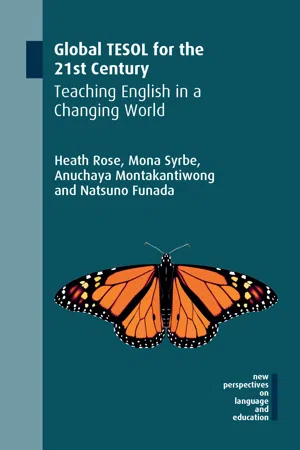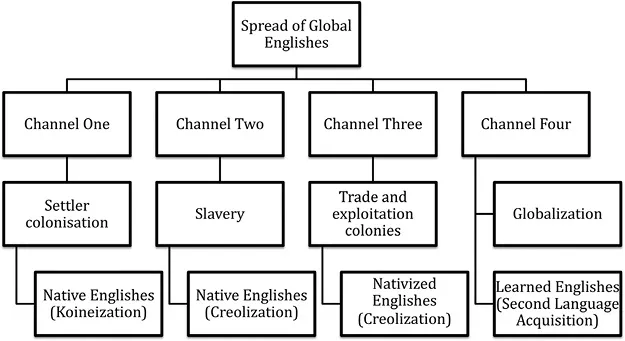
eBook - ePub
Global TESOL for the 21st Century
Teaching English in a Changing World
- 208 pages
- English
- ePUB (mobile friendly)
- Available on iOS & Android
eBook - ePub
Global TESOL for the 21st Century
Teaching English in a Changing World
About this book
This book explores the impact of the spread of English on language teaching and learning. It provides a framework for change in English language teaching to better reflect global realities and current research. The authors examine the pedagogical implications of the global spread of English, drawing on world Englishes, English as a lingua franca, and global Englishes research. The book proposes key innovations for teaching English as an international language, and outlines key areas for future classroom-based research. The book is essential reading for postgraduate researchers, teachers and teacher trainers in TESOL and second language education programmes.
Frequently asked questions
Yes, you can cancel anytime from the Subscription tab in your account settings on the Perlego website. Your subscription will stay active until the end of your current billing period. Learn how to cancel your subscription.
No, books cannot be downloaded as external files, such as PDFs, for use outside of Perlego. However, you can download books within the Perlego app for offline reading on mobile or tablet. Learn more here.
Perlego offers two plans: Essential and Complete
- Essential is ideal for learners and professionals who enjoy exploring a wide range of subjects. Access the Essential Library with 800,000+ trusted titles and best-sellers across business, personal growth, and the humanities. Includes unlimited reading time and Standard Read Aloud voice.
- Complete: Perfect for advanced learners and researchers needing full, unrestricted access. Unlock 1.4M+ books across hundreds of subjects, including academic and specialized titles. The Complete Plan also includes advanced features like Premium Read Aloud and Research Assistant.
We are an online textbook subscription service, where you can get access to an entire online library for less than the price of a single book per month. With over 1 million books across 1000+ topics, we’ve got you covered! Learn more here.
Look out for the read-aloud symbol on your next book to see if you can listen to it. The read-aloud tool reads text aloud for you, highlighting the text as it is being read. You can pause it, speed it up and slow it down. Learn more here.
Yes! You can use the Perlego app on both iOS or Android devices to read anytime, anywhere — even offline. Perfect for commutes or when you’re on the go.
Please note we cannot support devices running on iOS 13 and Android 7 or earlier. Learn more about using the app.
Please note we cannot support devices running on iOS 13 and Android 7 or earlier. Learn more about using the app.
Yes, you can access Global TESOL for the 21st Century by Heath Rose,Mona Syrbe,Anuchaya Montakantiwong,Natsuno Funada in PDF and/or ePUB format, as well as other popular books in Languages & Linguistics & Education Teaching Methods. We have over one million books available in our catalogue for you to explore.
Information
Part 1
Theoretical Foundations
1Theorising the Teaching of English in Global Contexts
Pre-reading Activities
Think
Look at Figure 1.1, which depicts the spread of English as an international language. Think about how the different ways that English has spread may have affected the language used in various global contexts. In what ways does English differ among the contexts with which you are familiar?
Discuss
In small groups, discuss the following questions:
(1)Why do some fields of study prefer to use the plural ‘Global Englishes’ as opposed to ‘Global English’ when referring to English as an international language? Do you think pluralisation is necessary?
(2)Most statistics suggest that the bulk of English users today are second-language users who have acquired English via Channel 4 spread, and the second most populous English speakers are bi/multilingual speakers from Channel 3 spread. What implications does this have in terms of learners’ likely future use of the language?
(3)What implications does the spread of English have in terms of how the language should be taught in English language classrooms in global contexts?
Introduction
The rise of English as a global language has been well documented in the linguistic research literature. In just 500 years, the world has seen English grow from a national language spoken by fewer than 3 million people, to a global language with an estimated 2 billion speakers. During the 20th century, the world quickly moved from a situation where first language (L1) speakers constituted the majority of English users to the current reality where second, foreign and additional language (L2) users are in vast majority. The spread of English is a complex, historical phenomenon, that is intertwined with British colonialism and globalisation alongside numerous other political and social forces (see Chapter 3 for an overview of the driving forces). The ways in which English has spread can be viewed include: political, historical and linguistic. Figure 1.1 represents an alternative perspective that captures the sociolinguistic forces of English spread via four main channels.
The first major wave of English dispersion occurred as a result of British colonialism, where the language spread around the world to places as far flung as Australia, Canada, Jamaica, Nigeria, Singapore and India. Subsequent changes to the language greatly depended on how the language was spread, because linguistic change is highly susceptible to exogenous forces (i.e. forces external to the language itself). Exogenous change occurs when speakers of a language come into contact with speakers of different dialects and languages. Change usually occurs in favour of the language that has more social prestige attached to the identities of these speakers. For example, if South-West English, Northern Irish and Scottish speakers came into heavy contact in a new community in the 1700s, the dialects spoken by the Irish and Scottish speakers may have been more likely to change due to the power held by the English during this time. Differences in population size and the context of the language contact gave rise to new Englishes in various parts of the British colonies. In contact situations typified by Channel 1 spread (e.g. in British colonies in New Zealand and Australia), the English language underwent a process of koineisation, which occurs when speakers of different dialects of English come into contact, and a new dialect emerges as a result. In contact situations typified by Channel 2 spread, the English language was subjected to creolisation, which was the result of speakers of languages other than English in sudden intense contact with English. For example, slavery forced different linguistic communities to adopt English as their primary, and often sole, lingua franca in plantation colonies. Both Channel 1 and Channel 2 saw the emergence of new forms of Native Englishes, via different linguistic processes. Channel 3 contact situations also resulted in the creolisation of English as a contact language, however this process typically occurred over a long period of time after going through an initial period of pidginisation. This channel of spread was also contextually typified with English being used alongside other more dominant local languages. For example, in Singapore, English was (and still is) used alongside Chinese, Malay and Tamil. In contexts where the role of English was reinforced as a language of education, law or political, it usually gave rise to nativised varieties of English, such is the case in Singapore. In other contexts, the role of English was diminished during post-colonial times, and thus plays a lesser role, such is the case of Malaysia.

Figure 1.1 The four channels of English Spread (adapted from Galloway & Rose, 2015: 14)
The second major wave of English dispersion is seen as Channel 4 spread. As a result of 20th century globalisation, English emerged as a global prestige language due to the economic and political power of the USA during this period. Thus, wrongly or rightly, English was seen by many educational policymakers as a means to facilitate individual and national upward economic and social mobility. Accordingly, globalisation saw the emergence of educational policies worldwide that emphasised the teaching of English as a foreign language in regions which had no previous colonial ties to English-speaking nations. This Channel 4 spread via the educational systems, for example in China, is the cause of the current global boom we are witnessing in the number of L2 English speakers. Thus, the majority of English speakers today can be said to have come into contact with English as a result of Channel 4 dispersion.
Exploring the global phenomenon – the rise of English as a global language – has occupied much applied linguistic and language education research in the previous few decades. The complexity in the ways in which English is used globally now attracts the attention of researchers from multiple perspectives: economic, political, linguistic, sociolinguistic, demographic, national and individualistic, to name just a few. It has also attracted the attention of educational researchers as it is inextricably linked with issues surrounding international education. As Chowdhury and Phan (2014) note, Teaching English to Speakers of Other Languages (TESOL) ‘has emerged an important field of choice for international students symbiotically accelerated by the growing dominance of English’ (2014: 1). This chapter introduces some of the core fields of research which underpin the concerns of TESOL researchers and practitioners associated with its global growth. The aim of this chapter is to develop a conceptual foundation for teaching English as an International Language in global contexts.
Key Concepts in Capturing the Spread of English
Research into the spread of English as a global language has resulted in the emergence of a number of interlinked academic fields of research within applied linguistics, which aim to explain the linguistic underpinnings of variation in English. Many of the fields also explore the sociolinguistic implications for the diverse contexts in which the language is now used. Paradigms for examining the spread of English include, but are not limited to:
•World Englishes;
•English as a lingua franca;
•Global Englishes;
•English as an international language.
Even though each of these terms has emerged from research with slightly different areas of focus, they all contain overlapping ideologies. For example, all terms position the English language as globally owned, thereby divulging power from so-called ‘native speakers’ in terms of informing global English language norms. All paradigms also emphasise the implications of the global spread of English for English language teaching practices – the very focus of this book. In order to understand these terms in more detail, each of them is outlined in turn in this chapter. Building on this foundation, we hope to establish our preferred use of ‘English as an International Language’ throughout the remaining chapters in this book.
World Englishes
The theoretical work of Braj J. Kachru and Larry Smith in the 1970s and 1980s is largely credited with kickstarting World Englishes as an independent field of study (see Kachru, 1976). Historically, the field was mainly concerned with exploring linguistic variation in English used around the world, with a particular emphasis on phonological and grammatical variation of English in British post-colonial countries. Figure 1.1 shows that the areas of inte...
Table of contents
- Cover-Page
- Half-Title
- Series
- Title
- Copyright
- Contents
- Tables and Figures
- About the Authors
- Preface
- Part 1: Theoretical Foundations
- Part 2: Global Classrooms and Curricula
- Part 3: Teachers and Learners of a Global Language
- Part 4: Initiating Change in TESOL
- References
- Index